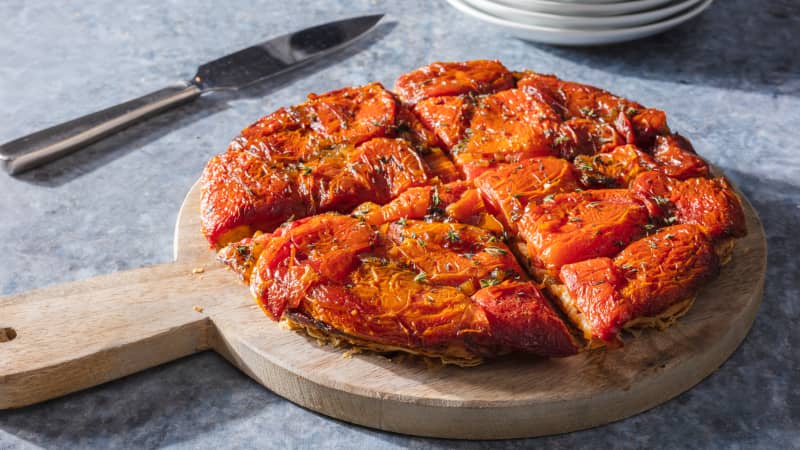I like the drama of an upside-down tart. The most famous example is a tarte Tatin, which consists of apples that are cooked in a caramel in a skillet; topped with pastry; baked; and inverted so that the pastry base wears the gleaming, deeply bronzed apple crown. It’s a treat that can’t help but impress. The framework has been adapted to seasonal fruits such as peaches, plums, and pears. So why not tomatoes? The bright, savory-sweet fruit would pair naturally with buttery pastry, and by adding components such as herbs and aromatics to a less-sweet stand-in for the caramel, I could easily shift my iteration from the traditional dessert squarely into savory territory.
Upside-Down Tomato Tart
Published June 1, 2021.

The Building Blocks
Plenty of upside-down tarts use store-bought puff pastry, and I saw no reason not to do the same. Packaged puff bakes up decidedly crisp and is frankly quite good; plus, it’s a much easier alternative to preparing pie or biscuit dough from scratch since it needs only to be thawed, rolled out if necessary, and cut before it’s ready to go into the oven. As for the tomatoes, luscious beefsteaks are my go-to for eating raw, but their juiciness would be a detriment. Instead, I turned to plum tomatoes, a cooking variety with meaty flesh and a lower moisture content. I got to work prepping a couple pounds, coring and halving them and then digging out their seeds and liquid-y gel (I didn’t dispose of this flavorful stuff; see “How to Core and Seed Plum Tomatoes” for a suggested use).
How To Core and Seed Plum Tomatoes

CORE WITH MINIMAL WASTE
Hold the tomato in one hand with the stem scar facing out. Insert the tip of a paring knife at an angle into the tomato at the edge of the stem scar, about 1/2 to 1 inch deep. Using a sawing motion, cut around the stem scar while rotating the tomato until the core is cut free.

THOROUGHLY EXCAVATE SEEDS AND GEL
Use your fingers or a spoon to get deep into the crevices on either side of the core to remove the seeds and gel. Save this flavorful jelly—which is packed with savory glutamates—to spoon over crusty bread; top it with a sprinkling of flake salt.
For a flavorful substitute for the caramel, I created a simple syrup by combining a modest 2½ tablespoons of sugar with ⅓ cup of sherry vinegar, cooking the mixture to thicken it and then enriching it with butter. I gently tossed the tomato halves in the syrup to coat them, fanned them around the pan, and simmered them for several minutes to help evaporate some moisture. Then I topped the syrup-slicked fruit with a 10-inch round of puff pastry and popped the whole thing into a 400-degree oven.

Watershed Moment
When I inverted the skillet, the tomatoes detached easily from its bottom. As I’d hoped, the syrup contributed just the right amount of sweetness, with balance and complexity from the vinegar and a faint richness and sheen from the butter. But the tomatoes hadn’t browned, and the pastry was so soggy that its flaky layers had fused together. Even though I was working with low‑moisture tomatoes, there was clearly still more liquid to get rid of. In my next test, I let the tomatoes cook in the syrup for a good 15 minutes before I topped them with pastry and slid them into the oven. When this measure barely made a dent, I salted the seeded halves and allowed them to drain before proceeding with the recipe. But even in combination, these steps proved woefully inadequate.
A Tart with Ultratomatoey Flavor and a Crisp Crust

ROAST TOMATOES
After reducing the tangy syrup, we add the tomatoes to the skillet and roast them for a full hour, concentrating their flavor.

BAKE WITH PASTRY
With much of the fruit’s moisture driven off, the store-bought puff pastry placed over top bakes up golden brown and crisp.

INVERT TART
Turning out the finished tart reveals lightly caramelized fruit gleaming with a sweet-tart glaze crowning the flaky, buttery base.
Get Roasted
A better, simpler idea dawned on me: I would roast the tomatoes so that the dry heat of the oven would evaporate more of their moisture from all sides. I once again made a vinegar syrup, shingled the tomatoes around the pan, and then roasted them at 400 degrees for an hour. The results were well worth it: The tomatoes had an even meatier texture and a more concentrated flavor. And the syrupy glaze had tightened in the oven, its sugar helping the fruit brown and caramelize around the edges. Best of all, after I’d topped the roasted tomatoes with the pastry and baked the tart for about 30 minutes, the crust retained its delicate crispness.

